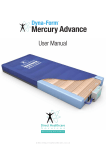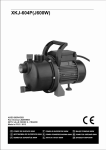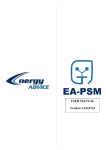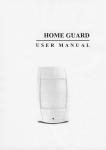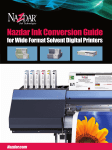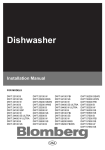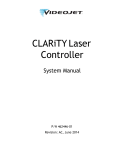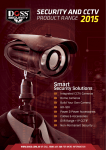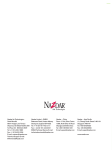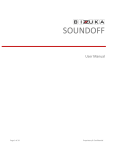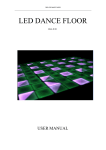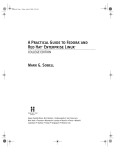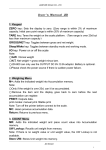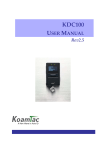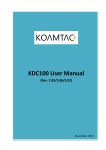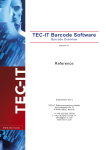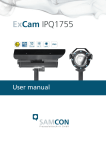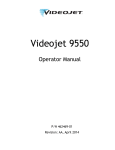Download 9000 Series - Logismarket
Transcript
9000 Series Quick Selling Guide 9, rue Gaspard Monge B.P. 110 26501 Bourg-lès-Valence Cedex - France Tél. : +33 (0) 4 75 75 55 00 Fax : +33 (0) 4 75 82 98 10 www.markem-imaje.com 150 Congress Street Keene, NH 03431 United States of America Tel.: +1 800-258-5356 Fax: +1 603-357-1835 9000 Series 9000 Series Sales and communications tools Already available 3-day training package (1) Datasheets (2) - 9020 - 9030 / 9030 IP65 - 9040 / 9040 S / 9040 IP65 - 9040 Contrast Printing Capabilities Brochure (2) Product video (2) Coming soon Product website from Q1 – 2009 (2) Customer presentation from Q1 – 2009 (2) Contact person (1) Sean Lyley – Sales Training Manager (2) Timothée Perrin – Communication Specialist Key figures N°1 worldwide in terms of CIJ units sold Leader in EMEA & LAM – N°2 in ASPAC & NAM (N°1 in some countries) Global Market Coverage with a strong presence in Industrial sectors: Tubes & Cables (Nexans, Valeo, Delphi) – Electronics (Foxcon, Tyco, LG) – Automotive (Hutchinson) – etc. Food and Beverage sectors: Danone, Nestlé, Unilever, Kraft, Coca-Cola, Pepsi, Perrier Pharmaceutical and Cosmetics sectors: Procter & Gamble, Henkel, Unilever, Merial, GSK, Pfizer N°1 in after sales services – the most represented coding solution supplier worldwide with 33 subsidiaries, 50 distributors, … covering 120 countries 9000 Series Product comparison Features 9020 9030 - 9030 IP65 Print head versions Single-jet Single or twin-jet 9040 - 9040 IP65 Single or twin-jet Single or twin-head 71 dpi 115 dpi 178 dpi (P head*) 9040 S - 9040 S IP65 9040 Contrast Twin-jet Single or twin-jet Printing Resolution 71 dpi (G head) 71 dpi 115 dpi (M head) 76 dpi* 71 dpi 115 dpi (M head) From 1.8 to 8.7 mm From 1.2 to 18.2 mm From 0.7 to 18.2 mm 2.3 mm From 1.2 to 18.2 mm 5, 7, 9, 11, 16, 24 dots 5, 7, 9, 11, 16, 24, 48 dots 5, 7, 9, 11, 16, 24, 2x24 dots 7 dots 2 lines only (1mm gap between the lines) 5, 7, 9, 11, 16, 24, 2x24 dots Up to 2,7 m/s Date, Postdate Counter, Shift-code Operator variable External variable Up to 5.5 m/s (* M head - 3 dot/mm resolution) * on 9040 1.1 only Character Height Fonts available Number of lines Up to 4 lines Up to 8 lines Up to 8 lines Max speed* Up to 4.4 m/s Up to 5.5 m/s Up to 5.5 m/s Variables Barcodes Date, Postdate Counter, Shift-code External variable (optional) Industrial: Distribution: Bi-dimensional: Languages available (32) Alphabet available IP rate Plant air mandatory Messages stored Connections Saving device Parallel interface Bent umbilical / head Umbilical length Automatical nozzle cleaning Ink base available Date, Postdate Counter, Shift-code External variable 2/5 interleaved, Code 39 Code 128, EAN 8, EAN 13, EAN 128, UPCA, UPCE, HIBC, HIBC LIC Datamatrix Industrial: Distribution: Bi-dimensional: Up to 8 lines 2/5 interleaved, Code 39, ITF 6, ITF 14 Code 128, EAN 8, EAN 13, EAN 128, UPCA, UPCE, HIBC/EAN Datamatrix Arabic-Brazilian-Bulgarian-Chinese-Croatian-Czech-Danish-Dutch-English-Finnish-French-German-Greek-Hebrew-Hungarian-Iranian-Italian-JapaneseKorean-Norwegian-Polish-Portuguese-Russian-Slovenian-Spanish-Swedish-Taiwanese-Thai-Turkish-Vietnamese (Indonesian only on 9020/30 and Romanian only on 9040) Latin-Arabic-Chinese-Cyrillic-Greek-Hebrew-Japanese-Korean-Thai IP54 IP54 / IP65 IP54 / IP65 IP54 No No - Yes, for IP65 version No - Yes, for IP65 version Yes Up to 100 Up to 880 Up to 2000 RS-232/422 (optional) RS-232/422 - Ethernet (optional) RS-232 - RS-422 (optional) - Ethernet PCMCIA / Compact Flash PCMCIA / Compact Flash / USB / SD No Yes Yes (optional) No Yes (optional) Yes (optional) 3m 3m, 5m, 8m 3m 3m (5 & 8 m under derogation) Yes Yes No Opaque Ketone & Alcohol Standard Ketone / Alcohol Ketone / Alcohol / Water (1 liter bottle) (1 liter bottle) (0.8 liter cartridge) For 9000 refer or S8C2, please refer“User to theManual” printer "User Manual" * Higher print speed can be available upon request Formore moredetails details,onplease to the printer 9000 Series 9000 Series 9020/30/40 Show & Sell The Cabinet – Reliability 9020/30/40 Show & Sell 9020 / 9030 Strengths Stainless steel cabinet, IP54 standard (no plant air required) / IP65 optional Compactness – One of the smallest and lightest cabinets on the market Quick & Clean access for consumable change without stopping the printer Unique wall mounting concept facilitates integration Quick connect/disconnect of accessories (photocell, encoder, alarm) Constant monitoring of consumable levels External laboratory certification on all IP ratings & security labels (CE, UL, GS, CSA, RoHS) Cartridge driven consumable change for more simplicity The User Interface – Ease of Use Icon driven interface - easy use of main functionalities via shortcuts (message selection / edition) Up to 60 minutes of printing autonomy when cartridge is empty ➠ The best printer to answer every standard customer need Intuitive consumable level monitoring for easy management Message modification available while printing (WYSIWYG display) 9040 Strengths “i” button enables instant access to machine status and alarm management More inks & colours available (MEK free, pigmented inks, etc.) to print on every substrate Over 30 operator languages available More printing options (twin-head, P head, up to 8m umbilical…) to adapt to every application Connectivity: Compact Flash for easy message uploading More connectivity as a standard to facilitate use and integration (SD, USB, Ethernet) The Printhead – Available at all times Perfect quality on jet start-up (automatic nozzle rinsing during start-up and shut-down) No additional accessories needed for integration - Stand alone concept Optimum cost of ownership for 3 shift applications: Robust and compact printhead resisting to shocks and vibrations Solvent savings (Peltier condenser) Longer lifetime in harsh working conditions (dual pump system) Extended running time (1 litre bottles – 200 hours of Protected electronic components allowing for very easy printhead cleaning running time, over 50 million characters) Jet Speed Control guarantees stable print quality Flexible and resistant umbilical (MEK proof) Twin-jet option to print more information at high speeds ➠ The best printer to answer every specific customer need 9000 Series 9000 Series 9020/30 vs. Domino A100+ Their Statement 9040 vs. Domino A200+ / A300+ Their Statement High reliability First choice for basic coding Connectivity & Flexibility High reliability High performance for industry Connectivity & Flexibility Our Perceptions Our Perceptions Strengths: Strengths: Good start-up (even after long stop) Stand alone printer (autonomous print head pressurization) Wide ink choice Weaknesses: Good start-up (even after long stop) Stand alone printer (autonomous printhead pressurization) Optional colour touch screen control Weaknesses: High running costs (low reliability – 20-year old technology): Ink tank to be changed every 600 hours (depending on air kit) requires production stop Waste up to 20% of ink when reservoir is changed 5 filters to change (Air, Make-up, Gutter, Main, Feed filter) Non-robust printhead (no protection on pipes and wires) Very basic coding solution: Print capabilities (1-2 lines of text, up to 16 dots, up to 2.4m/s, no barcodes) No clear information on consumable level Difficult to integrate: RS-232 only optional Heavy and cumbersome printer (needs a support) Not flexible and fragile umbilical (anaconda type) Only IP53 available High running costs (low reliability – 20-year old technology): Similar arguments as A100+ Limited print performances: Print capabilities (1-4 lines of text, up to 5.3m/s) No twin-jet / twin-head option Difficult to integrate: RS-232 only optional / No RS-422 Heavy and cumbersome printer (needs a support) Not flexible and fragile umbilical (anaconda type) Only 3m umbilical (6m optional) IP65 only available on A300+ (printer identical to A200+ for the other characteristics) ➠ 2 reasons to prefer a 9020/30: ➠ 2 reasons to prefer a 9040: Better TCO: only 1 air kit filter to change vs. 5 / no need to change reservoirs = no ink wasted / no production stop / robust & easy to clean printhead More options to facilitate integration: IP54 – IP65 optional / flexible and resistant umbilical / twin-jet version / light and compact printer Better TCO: only 2 filters to change vs. 5 / no need to change reservoirs = no ink wasted / no production stop / robust and easy to clean printhead More options to facilitate integration: IP54 – IP65 optional / flexible and resistant umbilical (3m, 5m, 8m) / twin-jet & twin-head / P-head 9000 Series 9000 Series 9020/30 vs. Linx 4900 Their Statement 9040 vs. Linx 6900 Their Statement Cleaner (Consumable management) Clearer (Head design / Friendly user interface) Cleverer (Foolproof operation) Ease of use (interface / consumable management) High print performances (high speed) Easy integration into any environments Our Perceptions Our Perceptions Strengths: Strengths: Good print quality Good start-ups Simple user interface These strengths exist as well for 9020/30 Good print quality Good start-ups These strengths exist as well for 9040 Weaknesses: Weaknesses: Non-optimized consumable management / TCO: Consumables supplied in 0.5l bottles / higher additive consumption frequent consumable change Leakage issues if topping up before the alarm No direct information on consumable levels Limited features: Unable to create new message when the printer is in production No barcodes, 1-2 lines text max, short umbilical (2m), 3 fonts available (5, 7, 16 dots) Up to 50 messages storage capacity No intuitive interface for 2-line message creation No IP65 version available for harsh environments Frequent and unsecured maintenance operations: Frequent maintenance required (every 2000h / or 2 times per year) No possible back-up on external device (such as Compact Flash) Risk of leakage on the electronic compartment ➠ 2 reasons to prefer a 9020/30: Better flexibility to meet customer needs for today and tomorrow: 1-8lines of text / from 5 to 48 dots / IP65 optional / all barcodes / Compact Flash for back-up Better TCO: solvent consumption reduced by 35% / 0.8l cartridges for less replacements / 60W power supply vs. 200W / less maintenance (ink circuit every 8000h and air filters every 8000h or once a year) Non-Optimized consumable management / TCO: Same as 4900 Exception: Linx “6900 Solver” has the same solvent consumption as the 9040 Frequent maintenance required (every 2000h / or 2 times per year) Less features (note that we have similar print speed at equivalent resolution): 1-5 lines of text, from 1.1mm to 13.8mm character height, datamatrix optional No possible back-up on external device (such as Compact Flash / USB / SD) Not suited to every applications: Only 2m and 4m (optional) umbilical / Ethernet only optional, no RS-422 Cumbersome printer: 592mm length + need for a table support + umbilical output (no twin-head option or bent head/umbilical) Small screen not suited for every sector (cables, extrusion): less comfort to display long messages 693 mm ➠ 2 reasons to prefer a 9040: Better flexibility to meet customer needs for today and tomorrow: 1-8lines of text / twin-jet and twin-head options / from 0.7mm to 18.2mm character height / all barcodes / 3, 5 and 8m umbilical as a standard / wider display (640 pixels) / better connectivity (Ethernet, USB, SD…) Better TCO: solvent consumption reduced by 35% / 1l bottles for less replacements / less maintenance (air filters every 3600h or 1 time per year / Pumps every 10000h) 9000 Series 9000 Series 9020/30 vs. VideoJet 43S Their Statement 9030 vs. VideoJet 1510 Their Statement Affordable printer High print quality Easy to use interface Advanced Technology Maximized uptime Simplified maintenance (could be performed by operators) Our Perceptions Our Perceptions Strengths: Strengths: A new printer with improved consumable management Minimum maintenance required Various print features (1D-2D barcodes, multi-lines, etc.) Compact printer / stainless steel Easy to use interface Air plant free These strengths exist as well for 9020/30 This product is designed to compete against our 9030, Features, Consumable management, and Running costs appear to be very similar. Protection cover hard to clean Weaknesses: Costs related to production downtime: Start-ups are not reliable Fragile print-head (frequent adjustments, leakage, hard to clean) Need to shut down the printer to refill consumables 3 filters require changing every 2000 hours or 6 months Limited print performances: Print capabilities (up to 4m/s - 3 lines of text - no 2D barcodes) Storage capacity (up to 25 messages) Only IP53 available User interface lacks of friendliness: No external saving device (such as Compact Flash) No “one touch” quick access keys, can be a complex operation Hard to understand icons No automatic font selection ➠ 2 reasons to prefer a 9020/30: Better up-time: better start-up / print-head needs no adjustments, easy to clean Consumable Management: constant monitoring of consumables level / consumable change on the fly / clean & easy to change Weaknesses: Missing printhead main features: No twin-jet version: max 5 lines / 34 dots at very low speed Only one printhead resolution (70µm nozzle) equivalent to our G head Lower resolution at equivalent speed (60dpi vs 71dpi) Printhead lack of reliability: Improved printhead but not as compact (241mm length) and robust as 9020/30’s Cover sleeve has to be removed during head handling operations leaving tubes & electro valve unprotected Visible tubes & ELV can be easily damaged during maintenance Self maintenance: non-trained operators could do some mistakes Non-guaranteed reliability in every environment: Questionable efficiency of IP65 rating without air. Testing methods may be different auto-certification? Need dry air kit and air plant for high humidity environment Sealed printer with no air flow = possible overheating & high consumable consumption ➠ 2 reasons to prefer a 9030: Better printhead features: up to 48 dots (twin-jet version) / higher printing resolution (M head – 54µm) / compact (180mm length), robust, and secure to clean print head / bent umbilical Guarantee to work in harsh conditions: our IP65 option is certified by an external laboratory (test are performed under extreme conditions) 9000 Series 9000 Series 9040 vs. VideoJet Excel 170i Ultra Their Statement 9020/30 vs. Hitachi PB / PXR Their Statement High print performances Low maintenance / Good Start-up Easy to use interface Low TCO (reduced consumption) Friendly user interface (large touch screen) Various printing functions Our Perceptions Our Perceptions Strengths: Strengths: Good print quality Long life printer & IP65 rating Easy to use interface Compact printer Wide ink range These strengths exist as well for 9030/9040 Weaknesses: Weaknesses: Non-optimized TCO & frequent maintenance operations: 4 filters to be changed frequently (every 1 200h or 2 400h) Ink must be replaced every 3 months (or 300 to 600 hours) Frequent pressure adjustments (to be checked every week) Umbilical and printhead lack of robustness Printhead difficult to clean (no protection on pipes and wires) Potential damage of pipes & tubes when replenishing the tanks Limited performances: Less print capabilities (up to 3 lines of text – 1.33mm to 18.3mm - no 2D barcodes) Pressurized air mandatory (60l/min 3600l/h) Connectivity out-of-date (no external saving device, no Ethernet) Frequent maintenance issues (20-year old technology): Printhead lack of robustness (leakage, frequent cleaning required, frequent nozzle exchange) No pump Use of external air required (need for additional air maintenance and frequent filter replacement) Old mono card with very complex circuit inside – increases maintenance cost Limited friendliness of the touch screen: Not WYSIWYG display / Not intuitive use Few operator languages available (only 12 on PB and 14 on PXR) No direct information on consumable level Limited printer friendliness: Need to stop production line to change consumable Messy consumable change (bottle management) Difficult to move from one line to another Heavy and rigid umbilical Limited features on PXR (even less on PB): Up to 4 lines, up to 32dots, 1-15mm character height Datamatrix only optional Storage capacity: 150 messages max Few print module configurations (no bent umbilical, no twin-jet) No IP65 option for demanding environments ➠ 2 reasons to prefer a 9030/9040: Better up-time: robust print-head needs no adjustment, easy to clean / no need for costly air maintenance to run the printer / easy to move Consumable management: constant monitoring of consumables level / consumable change on the fly / clean & easy to change ➠ 2 reasons to prefer a 9020/30: Better TCO: longer ink lifetime (1 year vs. 3 months) / only 1 air kit filter to be changed every 8000h / robust printer design (cabinet & printhead) Friendly user interface: WYSIWIG display / shortcut keys for intuitive use / constant monitoring of consumable levels / “i” button for easy alarm management









